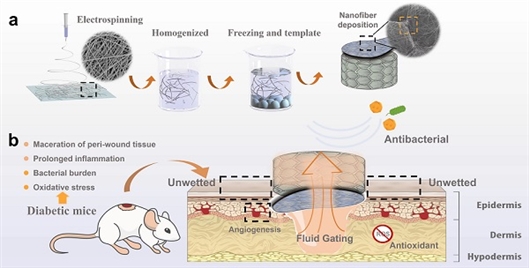Copyright © 2022 Foshan MBRT Nanofiberlabs Technology Co., Ltd All rights reserved.Site Map
Diabetes is characterized by wounds that are not easy to heal, and non-healing wounds can cause ulceration and infection. A large amount of exudate will be produced in the wound, and the accumulation of too much exudate will cause inflammation and delay the healing of the wound. Wound treatment has strict requirements for traditional dressings.
Qin Yan, a researcher at the Institute of Biophysics, Chinese Academy of Sciences, and Wen Yongqiang, a professor at the University of Science and Technology Beijing, jointly developed a nanofiber aerogel. This material has excellent antibacterial properties and antioxidant properties, which is beneficial to promote wound healing. At the same time, it has good flexibility and easy production, and it is expected to be used in clinical practice. Related research was published in the journal Biomaterials.
The team developed a Janus nanofiber aerogel with asymmetric wetting properties through physical and chemical improvements to nanofiber materials. Thanks to its fiber structure and fluid gate characteristics, this material can effectively absorb exudate and prevent reverse osmosis. As shown in Figure 1(a) below, the layered nanofiber sponge with controllable thickness and porosity is prepared by electrospinning and improved gas foaming technology. Successfully extended the two-dimensional nanofiber membrane to three-dimensional. Thanks to the good elasticity, high permeability and liquid absorption rate of the sponge, it can achieve accelerated hemostasis. As shown in Figure 1(a) below, experiments on mouse models of deep skin damage have shown that this sponge can promote wound healing and reduce scar formation. Moreover, the three-dimensional nanofiber sponge can provide packing for deep wounds, and use the dynamic microenvironment to regulate cell behavior.

Figure 1 (a) The development process of layered nanofiber sponge and (b) a schematic diagram of the treatment of diabetic wounds with Janus nanofiber aerogel.
Compared with traditional dressings, nanofiber material dressings have huge advantages. The nanofiber material is a kind of extracellular matrix structure and has good biocompatibility characteristics. It can absorb exudate efficiently, and the internal structure is conducive to cell gas exchange, and it can also inhibit bacteria from infecting wounds.
Related literature links:
https://doi.org/10.1016/j.biomaterials.2021.121040
https://doi.org/10.1016/j.biomaterials.2019.03.008
Electrospinning technology is a one-dimensional nanofiber preparation technology. Its advantages are simple manufacturing device, low spinning cost, many types of spinnable polymers, and controllable spinning process. At present, the application prospect of electrospinning nanofibers in the biomedical field is very broad.
In response to the market demand for biological dressings, the handheld nanofiber wound dressing electrospinning instrument of Foshan nanofiberlabs Co., Ltd. is characterized by its small size, light weight and easy operation.The instrument can prepare nanofiber membranes with different functions according to different solutions. It can be used to prepare nanofiber membranes with wound dressings.

Figure 2 Nanofiber electrospinning instrument for wound dressing